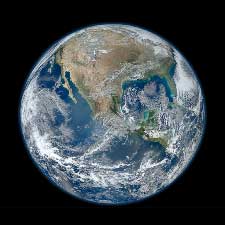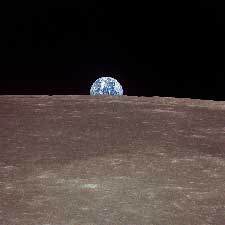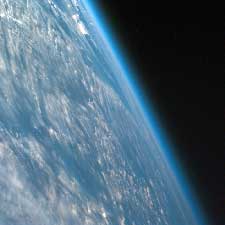Earth
The planet Earth is the third planet from the Sun and is the only planet in the solar system that is known to be able to sustain life. There are nearly 9 million different species on Earth and just over 7 billion humans.
Earth is the densest plant in the solar system and is known as a terrestrial planet. It has a solid, rocky surface that features numerous geographical features such as canyons, valleys, mountains, volcanoes and plains.
In this aspect it is similar to other terrestrial planets. However, it differs significantly in the sense that it is also an ocean planet.
Around 70% of the surface of the Earth is covered by water – this is not the case with any of the other terrestrial planets. Similarly the makeup of the atmosphere is vastly different to the other planets which when combined helps to give rise to life on Earth.
Earth Facts
Earth is our home planet and is the third furthest away from the Sun.
The name Earth is taken from the Anglo-Saxon word “erda” which means soil or ground. This is in contrast to the name convention of the other planets which are largely named after Roman mythological gods.
It is believed that the Earth was formed around 4.54 billion years ago.
The approximate ratio of land to water on Earth is 70% water and 30% of the Earth is land.
It takes the Earth 24 hours to complete a full rotation. This is why there are 24 hours in each Earth day. When one side of the Earth is facing the Sun, that side will have daylight and the other side will have darkness (night-time). As the Earth is continually spinning on its axis, after another 12 hours the opposite side of the Earth will have daylight as it will be facing the Sun and on the other side of the planet it will be night-time.
The closer you are to the north and south poles, the greater the variation in the hours of night and day.
The rotation of the Earth is fractionally slowing over time. It is virtually impossible to detect because the rotation is only slowing by around 17 milliseconds every hundred years or so. If this continues in 150 million years or so we will have a day that lasts for 25 hours.
The Earth makes a full orbit of the Sun (travels around the Sun fully) once every 365 and a quarter days. This makes up a full Earth year. Every four years our Earth year ads up to 366 days because we add the four quarter days to make a full day. This is known as a leap year.
The orbital speed of the Earth is 107,000 km/h.
The Earth is an average of 150 million km away from the Sun whilst in orbit.
The atmosphere of the Earth is composed of 78% nitrogen, 21% oxygen, 1% others which is the ideal mix that allows ourselves and animals to breathe. No other planet is known to have this type of atmosphere so if we were to ever visit any other planet we would need breathing apparatus to survive.
The Earth has one natural satellite known as the Moon. The Moon is currently the fifth largest moon in the solar system.
Earth does not have any rings.
There are numerous man-made satellites that are currently in orbit around the Earth at any one time.<
The Earth is unique in that the build-up of greenhouse gases is prevented by the plate tectonics that make up the Earth’s crust. The crust is made from a series of plates that can collide or slide beneath one another. Under these plates there is magma. By sliding under each other and separating it allows for the transference of dead plant and animal matter into carbon over time which is then pulled down into the interior of the Earth and recycled instead of being released into the air as harmful carbon based gases which we understand contributes towards the greenhouse effect.
Figures and Statistics
| Earth | |
| Rotation period - (hours) | 23.9345 |
| Length of day - (hours) | 24 |
| Length of year (earth days) | 365 |
| One complete orbit takes (earth days) | 365.256 |
| Radius (km) | 6378.1 |
| Mass (1024 kg) | 5.9726 |
| Volume (1010 km3) | 108.321 |
| Density (kg/m3) | 5514 |
| Distance from Earth - Min (106km) | - |
| Distance from Earth - Max - (106km) | - |
| Average distance from Sun (106km) | 149.6 |
| Orbital radius (106km) | 147-152 |
| Orbital velocity (average - km/s) | 29.78 |
| Rotational velocity (km/h) | 1674.4 |
| Surface gravity (m/s2) | 9.81 |
| Surface temp - Min (K) | 184 |
| Surface temp - Max (K) | 330 |
| Axial tilt (degrees) | 23.44 |
| Number of natural satellites (moons) | 1 |
-
Notes on the above figures:
- Orbits are invariably elliptical in nature. The average distance from the sun that appears above is also known as a 'semi-major axis', which is the mean (average) radius of the elliptical orbit.
- Axial tilt is also known as 'obliquity to orbit' and is the angle of rotation of the body itself with an imaginary line drawn through both poles, relative to its plane of orbit.
- Radius figures quoted are equatorial measurements. As most bodies exhibit 'oblateness' - that is to say that they appear slightly squashed - the radius from the centre to the poles would invariably be shorter.
- The Kelvin temperature scale is used for all temperature measurements above. 0K is equivalent to -273.15°C (degrees Celsius). To convert from K to C, simply subtract this figure from the Kelvin temperature given.
- Use of 'Index Notation' for very large numbers as above can be explained as follows; 106 = 10 x 10 x 10 x 10 x 10 x 10, or 1,000,000. For example, if you see a number that appears as 6x1011 then that number written in full would be 6 x 10 x 10 x 10 x 10 x 10 x 10 x 10 x 10 x 10 x 10 x 10 - or 600,000,000,000. Index notation allows us to write very big (or very small) numbers down far more concisely.


